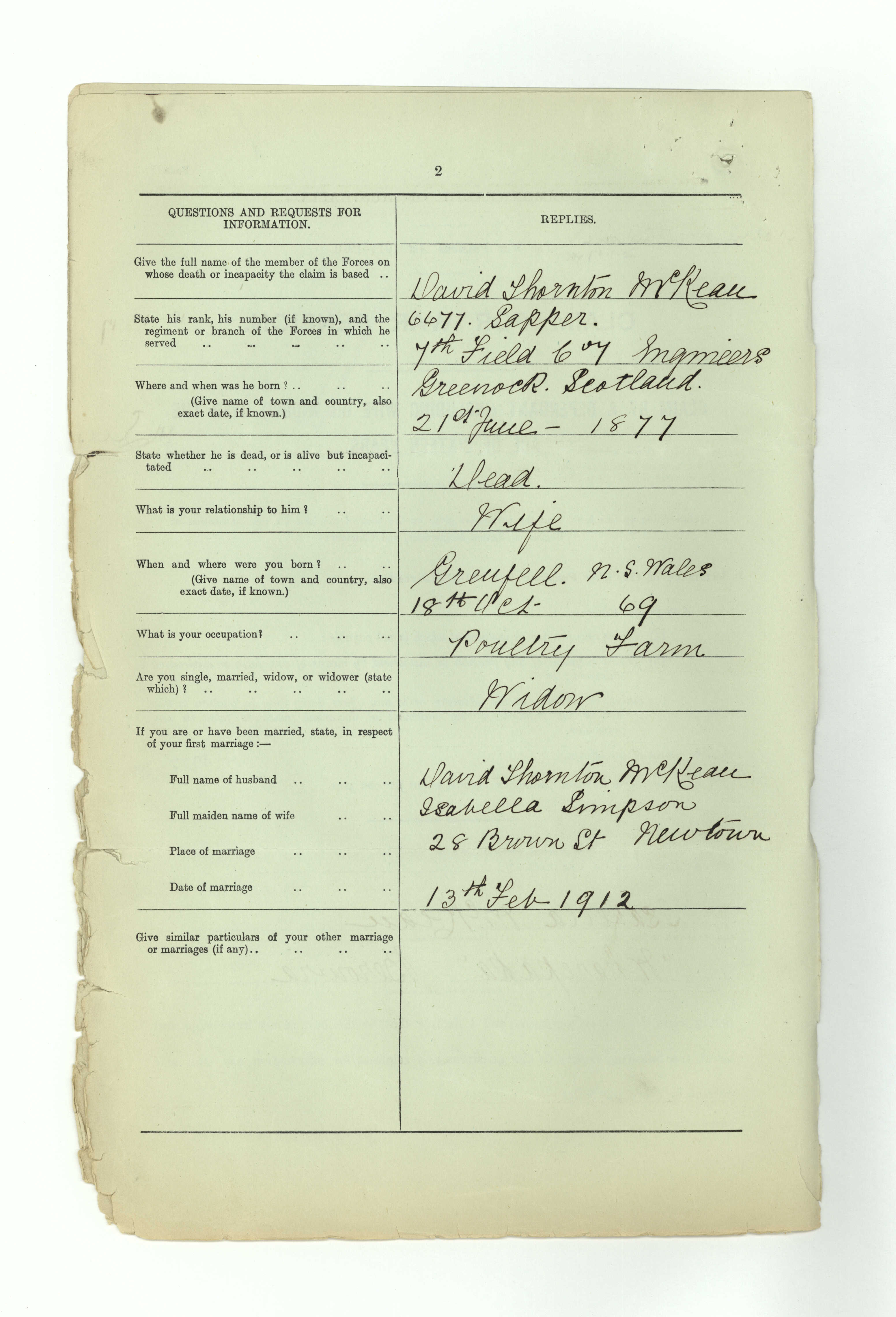Family historians, can you help us? We’d love to know more about Isabella McKean and source an image of her. Please get in touch if you can help.

Isabella Lailey (McKean), obituary, The Grenfell Record and Lachlan District Advertiser, 31 July 1939.
Isabella McKean
War widow, poultry farmer
Isabella McKean was widowed when her husband, Scottish-born David Thornton McKean, was killed in action while serving with the AIF on the Western Front on 14 November 1916. For a few years before World War I, David McKean worked as a plasterer with the Department of Home Affairs. In 1913, Isabella moved to Canberra from Weddin, where she had been active in church and social events, to join her husband but had trouble finding accommodation. She was living in Berowra when her husband was killed. In 1919 she married a former AIF solider and partly supported herself keeping poultry.
Isabella Simpson was born in 1869 at Grenfell, New South Wales, a daughter of John and Mary Ann Simpson. She lived in Weddin, near Grenfell, New South Wales, where she was active in social events and a loyal supporter of the Presbyterian Church. On 3 February 1912 at Newtown, Sydney, she married Scottish-born David Thornton McKean who was employed by the Department of Home Affairs as a plasterer at the new National Capital, where he was active in the fledging community. In July 1912, he played as a forward in the Department of Home Affairs team in an exhibition soccer match at Queanbeyan against a team from Duntroon Military College. This was the first time soccer had been played in the district. He was also noted in the press for his exhibition of illuminated club swinging at a farewell for a fellow worker, arranged by the Duntroon Social Club.
Isabella McKean remained in Weddin for about a year after her marriage as she was unable to find accommodation either in Canberra, where hundreds of workers constructing the new National Capital were accommodated in tents, or in nearby Queanbeyan where the population had swelled, and all hotels were full. In August 1913, when she left Weddin for Canberra, Isabella was farewelled at a gathering of residents and presented with a silver hot-water kettle. A few months later, David McKean giving evidence at an inquiry into the granting of a Publicans’ Licence in Queanbeyan, stated that he had been unable to obtain accommodation in the town for himself and his wife.
After the start of World War I in September 1914, work on building the National Capital slowed and virtually ceased during the following year. Workers left either to return to their home states or to enlist. When David Thornton McKean, 39, enlisted in the AIF in Sydney on 16 December 1915, Isabella moved to ‘Wharepaka’, Berowra, north of Sydney, then a sparsely populated rural area isolated by bad roads and difficult terrain where she kept poultry. McKean, 39, born in Greenock, Scotland, who had served in the Boer War with the Scottish Horse for nineteen months, was posted to 7th Field Company Engineers. From May to November 1916, he served in France on the Western Front erecting Nissen huts to accommodate soldiers behind the lines. His section moved to the front line at Flers in November and Sapper David Thornton McKean was killed in action on 14 November 1916 while constructing strong points in trenches just won from the Germans. He is commemorated on the ACT Memorial, Canberra, the 26 Villers-Bretonneux Memorial, France and Hornsby Shire Recollects memorial. He was further honoured when his name was projected in a ceremony at the Australian War Memorial on 23 September 2018 at 8.38 pm.

Claim for war pension from Isabella McKean showing her occupation as poultry farmer. NAA: C138 C22711 & C128467
On 1 February 1917, Isabella McKean, 48, was granted a war widow’s pension of £2 per fortnight. Following her second marriage to a much younger man, William Charles Lailey, at Marrickville, New South Wales on 18 October 1919, her war widow’s pension continued for another two years, the time allowed for readjustment under amended legislation. English-born Lailey, 25, a miner born in Reading, had enlisted in the AIF in 1915 and been posted as a reinforcement to the Light Horse in Egypt. He was admitted to hospital in Abbassia in May 1916 with defective eyesight, claimed to have been caused in a training accident, and returned to Australia. Discharged medically unfit early in 1917, he was granted a pension of £3 a fortnight but this was reduced later to £2 a fortnight and cancelled on 8 October 1918 when it was decided that his disability was not caused in connection with war operations. At the end of December 1921, the Postmaster at Hornsby was instructed to retrieve Isabelle Lailey’s war widow’s pension card. Her pension ceased that month leaving her and her second husband dependent on whatever income they could make from the block at Berowra.
The combined Repatriation Department file of David Thornton McKean and William Charles Lailey covers an extraordinary length of 426 pages, most of which concerns Lailey’s second marriage after Isabelle McKean/Lailey’s death in 1939, his service in World War II and disputes about repayment of a means-tested service pension. Isabelle Lailey died at Berowra on 28 July 1939, aged 69.
DR PATRICIA CLARKE OAM FAHA
Archival resources
- NAA, B2455, First AIF Personnel Dossiers 1914-1920, McKean, David Thornton, 6677, barcode 1948772.
- NAA B2455, First AIF Personnel Dossiers 1914-1920, Lailey, William Charles, 1704, barcode 7379200.
- NAA C138, Personal Case Files, single member series 1914-1918, C22711 and C28467, McKean, David Thornton, 6677, and Lailey, William Charles, 1704, 1948772, 14083065.
Published sources
- Queanbeyan Age, 19 July 1912, p. 2; 15 August 1913, p. 2; 17 October 1913, p. 2.
Online sources
- ACT Memorial, McKEAN, David Thornton www.memorial.act.gov.au/search/person/mckean-david-thornton
- AIF Project UNSW www.aif.adfa.edu.au/showPerson?pid=200228
- New South Wales Birth, Deaths and Marriage records: Birth Isabella Simpson, 1869/13826; Marriage Simpson/McKean, 1912/2663; Marriage McKean/Lailey 1919/12680, Marrickville, NSW; Death Isabelle Lailey,1939/17464, Hornsby, NSW.